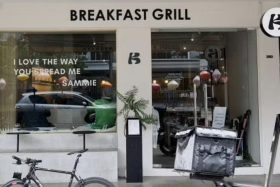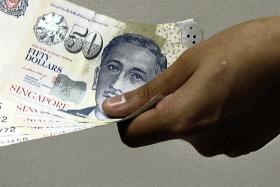Going cashless in Singapore challenging but not impossible
TNP reporter Linette Heng was tasked to go cashless for two weeks by using new e-payment apps. Easy?
I paid for a $3 bowl of porridge at a hawker centre in Toa Payoh using my phone last week and all it took were a few taps.
I opened the DBS PayLah! app, took a photo of a quick response (QR) code on a laminated sheet of paper provided by the hawker and keyed in the amount. The stall holder just had to check my phone screen, which showed the transaction was complete.
Although the 52-year-old agreed it was surprisingly convenient and easy to use, he told me I was only the second customer to request this payment method in two months.
It was so under-used that the QR code was hidden in a corner of the stall. (I knew they offered this payment option after I looked through a list of merchants on PayLah!'s website.)
Paying with a mobile phone instead of cash at a hawker centre may seem novel now, but this may change soon.
About 90 per cent of consumer transactions at hawker centres and wet markets today involve cash, consulting firm KPMG Advisory said last year.
Last month, the Government issued a Request for Information to crowdsource views and ideas for e-payment solutions at hawker centres, coffee shops and other shops in Singapore's heartland.
For now, it seems like the QR code is going to feature heavily in such payments.

The Payments Council, established by the Monetary Authority of Singapore (MAS), has set up a taskforce to develop a common QR code for Singapore by the end of the year.
Banks, QR payment service providers, and industry players, such as Nets, are also involved.
Nets launched its standardised QR code at shops and 50 stalls at the Tanjong Pagar hawker centre on Saturday, with plans to roll it out to 30 more hawker centres by the end of the year.
The QR code will be an "infrastructure-light and cheaper" solution, attractive to smaller, cash-based merchants as it would not require credit and debit cards, which involve hefty transaction fees.
I embarked on a cashless challenge for two weeks .
This involved downloading new apps on my phone - for instance, PayLah! and OCBC Bank's Pay Anyone - in case a merchant required an app I did not have. These steps may prove a deterrent.
I had to re-activate my PayLah! account - it took about a few minutes to reset a long-forgotten password - but considering how easily I could use it at different merchants, I reckon it would make up for lost time if I use it often in the future.
Fintech firms and banks have been the mainstays in the local e-payments landscape, but seemingly unrelated companies have thrown their hats into the market in recent months.
Telco Singtel was one of the earliest adopters of e-payments, partnering with Standard Chartered Bank to launch Dash in 2014.
RELAUNCHED
The app, which is now available to subscribers of other telcos, was relaunched in July and has more than 50,000 acceptance points and 500,000 users.
Transaction values have increased by more than 30 per cent in the past month, said a spokesman.
Fave, formerly known as deals website Groupon, launched mobile payments platform FavePay in Singapore and Malaysia last month.
The app is focused on helping its close to 500,000 users find deals, but FavePay now allows them to make payments through the app at 250 food and beverage merchants.
To entice customers, attractive cashbacks are offered.
I used FavePay to buy a $3.60 coffee milk tea at Each A Cup, and it was a thrill when I realised my next bubble tea purchase will cost 72 cents less. For me, this justified downloading a new app.
Familiarity and the assurance of security with the usage of existing apps would help convert non-believers to e-payment.

Ride-hailing company Grab announced recently that it plans to trial cashless payments beyond transport, and will offer its payment platform to 1,000 merchants, mainly those that rely heavily on cash, by the end of the year.
Grab users are familiar with using mobile payments. More than 75 per cent of Grab users here use cashless method GrabPay to pay for their rides.
As a security measure, Grab also introduced a new six-digit GrabPay PIN as its second factor authentication method.
Customers with more than $150 worth of credits in their GrabPay account are required to activate the PIN.
But are more players necessarily better?
Prime Minister Lee Hsien Loong alluded in his National Day Rally speech last month to the myriad e-payment options that may be holding Singapore back in its cashless push.
Mr Lee had noted that having many systems of e-payment is inconvenient for consumers and costly for businesses.
He said: "In Singapore, we too have e-payments, but we have too many different schemes and systems that don't talk to one another. People have to carry multiple cards, and businesses must install multiple readers."
I used FavePay to buy a $3.60 coffee milk tea at Each A Cup, and it was a thrill when I realised my next bubble tea purchase will cost 72 cents less. For me, this justified downloading a new app.
But both Grab and Fave do not see themselves as adding to the already-crowded market as they are tapping on their large, existing customer base who are already making use of cashless payment options for their services.
Head of GrabPay Jason Thomson said at the launch of its peer-to-peer transfer service last month that it sees itself as consolidating, rather than fragmenting, the market.
He added: "A lot of the wallets don't have a usage model, but we are approaching it from an opposite direction. Our wallets are already existing in Singapore, and already used every day in Singapore. We are just allowing (people) to use it more."
LOW COST
These companies also promise low cost for merchants, with Fave offering no transaction fees for the first three months and 1 per cent thereafter for its first 1,000 merchants in Singapore.
Grab pointed out that mobile payments will not incur additional fees such as rental of payment terminals, and merchants will get access to the ride-hailing app's customers as well as increased marketing exposure.
Nonetheless, some merchants may still need coaxing .
KPMG's study showed that retail businesses "overwhelmingly" preferred cash due to perceptions around its convenience and security.
Slow settlement speed, cost and fraud were listed as top challenges faced with cashless modes of payments.
Online payment platform PayPal recently addressed a common bugbear of merchants - the higher cost of using cashless payment modes. In Singapore, PayPal charges merchants 3.9 per cent a transaction, while payment gateway Stripe charges 3.4 per cent and 50 cents.
A 3 per cent transaction fee is imposed on merchants for accepting Visa and Mastercard payments. The same fee applies when they accept mobile wallets such as Apple Pay, Android Pay, and Samsung Pay.
These costs are lower elsewhere. The European Union has capped credit card transaction fees at 0.3 per cent and China at 0.45 per cent.
Mr Rahul Shinghal, South-east Asia general manager of PayPal, argued that the benefits of using digital payments, such as increased sales and traffic, far outweigh the cost.
He said: "Many people have the misconception that cash is free. But taking cash, handling it, having security sometimes means (the cost) is much higher than electronic payments."
MAS estimated that the social costs of cash and cheques is around 0.5 per cent of the Republic's gross domestic product, or about $2 billion a year.
Most of these costs can be attributed to the cost of securing cash, both in transit and in storage, and processing cheques.
ACCEPTANCE
For now, the biggest barrier in this cash-loving society may just be acceptance.
There was disquiet last month when the Land Transport Authority (LTA) announced the public transport network will go cashless by 2020, with many citing concerns for the elderly, young and poor.
This is despite assurances that cash alternatives for the sale and top-up of stored value cards are available nearby, for example, at convenience stores.
The lack of confidence is also rampant among merchants.
PayPal's recent study, which surveyed 200 merchants here, showed 65 per cent of them think it is getting more difficult for them to follow the new trends in payment methods.
But speaking from experience, sometimes it is just about taking the first step.
When I tried to pay for a $33 manicure at a nail parlour at Dhoby Ghaut using the new Nets QR code, the manicurist admitted she had not watched training video yet. When I tried again at a Delifrance outlet, only one of the three staff members knew how it worked.
He printed a QR code on a receipt and told me to scan it.
For some reason, the QR code could not be detected by my phone camera. I was about to take out $4 in cash to pay for my eclairs but he did not give up.
"It is okay, there is no queue. Let us try again," he said as he printed another code.
It worked this time, and I think both of us are more comfortable with using this method.

Mobile payment method hoping to be a Fave with retailers and consumers
Andersen's of Denmark was not looking to adopt another cashless payment method, but wanted to boost customer retention by improving their rewards programme.
The ice cream chain, which has six outlets in Singapore, initially expected technical issues when they started accepting FavePay, one of the newest mobile payment methods here.
To their surprise, transactions went smoothly and the company benefited from real-time transaction reports and detailed statement of account reports.
Better known for offering discounts at food and beverage (F&B) outlets, Fave is now hoping for a slice of the growing mobile payment market in the region.
Fave, which acquired Groupon in Malaysia, Singapore and Indonesia over the past year, announced late last month that it would start offering mobile payment options.
The mobile payments platform FavePay is available in Singapore and Malaysia, and will be launched in Indonesia later this year.
In Singapore, we too have e-payments, but we have too many different schemes and systems that don't talk to one another. People have to carry multiple cards, and businesses must install multiple readers.Prime Minister Lee Hsien Loong in his National Day rally speech
It is available at outlets such as Four Seasons Durians, Rong Hua Bak Kut Teh and Yum Cha.
To boost adoption, it is offering cashback of up to 30 per cent that customers can use on their next visit at the same F&B merchant.
For instance, customers who use FavePay at Andersen's of Denmark get 20 per cent cashback on their next visit.
Customer adoption rate across the region is going up by about 60 per cent each week and there are "tens of thousands of transactions", Fave's Singapore managing director Mr Ng Aik-Phong told The New Paper last week.
Fave also provides merchants with a proprietary dashboard called FaveBiz that will allow them to get real-time reporting, monitor performance and receive direct customer feedback.
These merchants have the option to accept Alipay, one of the world's largest online and mobile payment platforms.
"Deploying FavePay to help restaurants and retailers succeed is one of the pillars of Fave's business model. Together with Alipay, we provide fast and easy cashless mobile payments," said Mr Ng.- LINETTE HENG
Get The New Paper on your phone with the free TNP app. Download from the Apple App Store or Google Play Store now







